DIY garage oven: an overview of the best homemade options
Private garage is a specific room and in winter it is usually very cold. Neither for a person nor for a car such a microclimate is completely useful. At the same time, the use of standard electric heaters is often too expensive and ineffective.
It remains to make a furnace for the garage with your own hands, choosing one of the suitable options. We offer for consideration four ways of arranging furnace heating, each of which has its own characteristics in the creation and operation.
Visual diagrams and video instructions will help determine the design of the furnace, complete assembly and connection of the unit yourself.
The content of the article:
Features of garage heating
A capital garage with insulation is not available to every car owner. Most often, the owner of the vehicle has a metal structure devoid of any insulation. Any thermal energy leaves such a structure almost instantly.
When solving the problem of heating a garage, you should not evaluate its need for heat, based on similar experience with a residential building. And it's not just the lack of thermal insulation.
There is the so-called square-cube law, which states that when the dimensions of a geometric body decrease, the ratio of the surface sizes of this body to its volume increases.
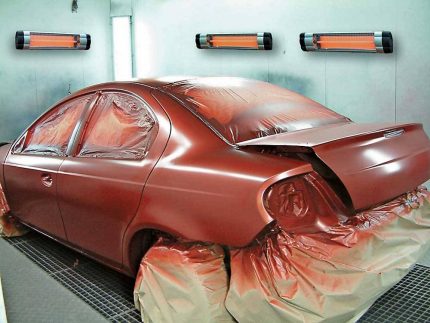
This affects the size of the heat loss of the object, therefore, for heating one cubic meter of a small room, for example, a garage, more heat is needed than when heating a large house.
If a heating device with a capacity of 10 kW can be enough for a two-story building, then a unit with a capacity of about 2-2.5 kW of thermal energy will be needed for a much smaller garage.
To maintain a very modest operating temperature at 16 ° C, enough stoves with a capacity of 1.8 kW. If you need to maintain only the optimum temperature for storing the car in the parking lot - 8 ° C - a 1.2 kW unit is suitable.
It turns out that fuel consumption for heating a unit volume of garage space can be twice as high as a similar indicator for a residential building.
To thoroughly warm the entire garage, its walls and floor, you will need even more thermal energy, i.e. even more powerful heater. But even if there is insulation, the heat will leave the room too quickly. Therefore, it is recommended to heat not the entire garage, but only the so-called working space.

The idea is to concentrate the warmed air in the center of the room and around it so that there is a layer of cold air between the walls and the ceiling. As a result, equipment and people will constantly be in a cloud of air at a comfortable temperature, and the consumption of thermal energy will noticeably decrease.
Specialists call this phenomenon a warm hat; it arises due to naturally limited convection. The intense flow of heated air rises, but does not reach the ceiling a little, because its kinetic energy is extinguished by more dense cold layers.
Next, the hot stream is distributed on the sides, slightly touching the walls or at a small distance from them. Almost the entire garage becomes warm, even a viewing hole warms up under the influence of convection processes.
To achieve this effect, garage stoves of relatively low power are suitable, creating an intense, but not particularly dense stream of warm air.

An alternative option for heating a garage is to use a variety of infrared heaters. For a garage with metal walls, such equipment is not particularly suitable. Infrared radiation is poorly reflected from metal surfaces, it penetrates through them, as a result, all the heat just goes into the street.
Experts also do not recommend an infrared heater for a brick garage with half-brick walls. This material does not transmit infrared waves, but does not reflect them either. Brick absorbs this type of thermal energy and eventually gives it away. Unfortunately, the process of energy storage and its return takes too much time.
Practical recommendations for choosing a garage heater are given in this article.
Use of insulation: pros and cons
Economy class garages are almost never insulated from the outside for a very simple reason - it is too expensive for a room that is not always used. Yes, this is not always possible, for example, in garage cooperatives, buildings are placed very close to each other, the gap does not allow the installation of insulation.

But the internal thermal insulation of the garage space can be problematic. When mounting the insulation material directly on metal walls, the so-called dew point occurs at their contact point, i.e. condensation area. Almost always, when in contact with moisture, the insulation deteriorates quite quickly.
And for the structure itself, such a situation can be fatal. In a metal garage, insulation can be supplied, but it is better to install a suitable material at a certain distance from the wall, about 20-50 mm.
50-70 mm should be retreated from the floor. It is best to use washers as a profile to avoid creating closed circuits under the coating.
With this installation option, condensate will also appear, but due to air circulation under the insulation layer, moisture will gradually evaporate without causing noticeable damage to the structure.
However, for a garage that is constantly heated, this option is not suitable, since the humidity in the room most of the time will be excessively high. This will jeopardize both human health and the condition of the car.
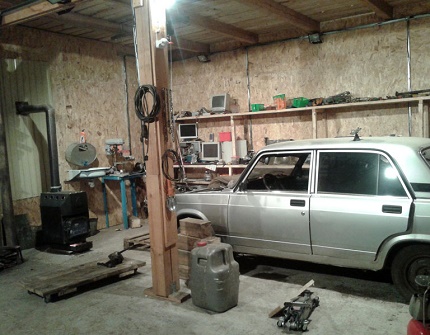
As a material for such a “ventilated” insulation, it is recommended to use plates, for example, fiberboard, chipboard, that is, wood materials, self-extinguishing when ignited. Recommended thickness is about 5 mm.
Perfectly suited flat ondulin or its analogues. These materials have the ability to reflect infrared radiation, which ensures efficient heating.
But plastic, even with damping properties, to put in the garage is strongly discouraged. When ignited, such materials emit toxic fumes, due to which people who escaped the fire can simply get poisoned. It is forbidden to use as insulation also plates, which contain asbestos.
When warming a cold brick garage, it is recommended that you first plaster the walls with vermiculite to protect them from moisture. The walls of the metal garage should be painted in two layers, after priming the base.
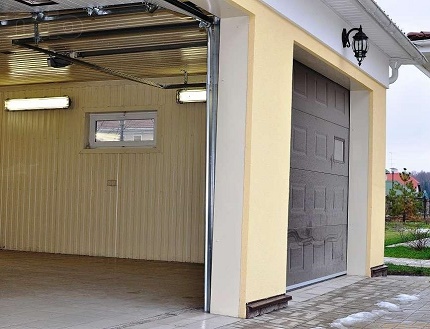
Overview of Options
For the garage, most often use the following options for homemade stoves:
- brick wood stove;
- potbelly stove;
- long burning furnace;
- the furnace is being worked out.
Each of these do-it-yourself garage oven options has certain advantages and disadvantages. Some units can be combined to expand the possibilities for heating the garage and make this process more convenient and profitable.
In the construction of a small stove in the garage, you can actually use junk tools and materials, these are:
# 1: Brick - problems may arise
A brick stove is sometimes made in a garage, although this is not the easiest option. A device with a base on two by two and a half bricks will cope with heating a small space.
However, such a furnace does not heat up too quickly, and then gives off heat for a long time. Therefore, it is not very suitable if the owner enters the garage only for a short time.
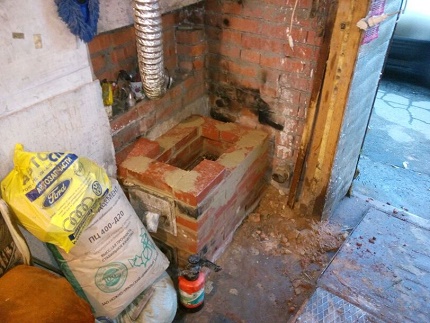
It is almost impossible to create the warm cap mentioned above with a wood stove, since it is not able to produce a sufficiently intense stream of warm air. It is recommended to melt such a furnace in advance, about an hour before starting work.
To lay down a wood stove of this type, you will need refractory and fireclay bricks.Refractory clay and fireclay powder should be added to the masonry mortar. The fuel chamber is made at the level of the second or fourth rows, which usually do not exceed nine in the masonry. Of course, you need to arrange a chimney.
It is also made of refractory bricks, and a steel insert is placed inside. The chimney is discharged through the roof, the masonry should be neat and even.
When choosing a brick oven for your garage, you should remember that constant moisture drops after some time will lead to a deterioration in the viscosity of the masonry mortar - the device will not last too long.
# 2: Potbelly stove - simple and reliable
The easiest option for a homemade stove in the garage is making ordinary potbelly stove. It is not difficult to make from improvised materials. Sheet metal, and an old gas cylinder, and a piece of pipe or an unnecessary barrel will do.
The main thing is that the metal thickness is at least 5 mm. If a cylindrical object is used, then its cross section must be at least 300 mm.
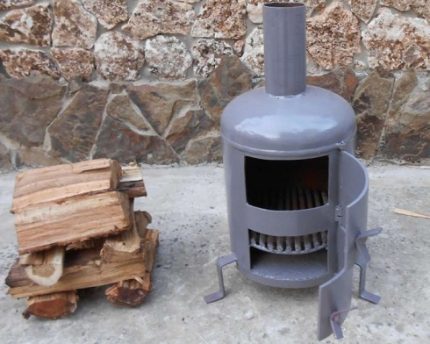
It is recommended to take a metal pipe with a wall thickness of 2-3 mm and a cross section of at least 120 mm into the chimney. A furnace chamber is cut out of metal or a workpiece (cylinder, pipe, barrel, etc.). At the bottom, arrange a grate for fuel, and under the grate make a box for collecting ash. For this element, metal 3 mm thick is also suitable.
At the top, the camera is closed and vertically remove the chimney. It remains only to attach the legs from a metal corner. To increase the heating efficiency, some craftsmen weld small metal “wings” to the sides of the stove.
This will increase the area of contact of air with hot metal and accelerate the heating of the room.

For a potbelly stove, you should prepare an even and strong base, covered with fireproof materials. Surrounding walls should also be protected from possible fire. In addition, in the immediate vicinity of the stove should not be any foreign objects.
The surface of such a stove can heat up to very high temperatures. Keep in mind the danger of serious burns if you accidentally touch it.
In the manufacture gas bottle pots care must be taken. There have been cases of explosion of gas residues when sawing such a container. Experts recommend pre-filling the cylinder with water in order to displace combustible residues.
The following photo selection will familiarize you with the manufacturing process of a stove-potbelly stove from an empty gas cylinder:
The construction of the main part of the future garage stove has been carried out, it remains only to weld a chimney to it and bring the pipe out:
Before the construction of the stove from the empty cylinder, the container itself must be “burned”. It is better to do this in some desert place, on a fire, removing old grass and all flammable objects around it within a radius of 2-3 meters around it. It’s even better to mow new vegetation almost under a trimmer.
Before firing, the valve must be separated from the cylinder, i.e. cut it off. The container itself should be placed strictly horizontally directly on the firewood and cover the side walls with firewood. Then it is necessary to fill in a little liquid for ignition and set fire to the entire “styling” necessarily from the bottom.
When the flame of the fire seizes and begins to flare up, you need to move away from the fire to an extremely long distance. But not so that it was not possible to put out if necessary. All actions are carried out with a fire extinguisher next to you, stock up at least with a car option or water in buckets.
This video demonstrates the experience of making a classic stove:
# 3: Furnace in development - efficient, inexpensive
The design of such an aggregate is a bit more complicated than a potbelly stove, but its efficiency breaks many records. Every motorist will have used oil, and if it is not enough, then you can buy such fuel in almost any car service at a more than reasonable price.
Unlike a potbelly stove, such a furnace is made of two sections connected by a perforated metal pipe.
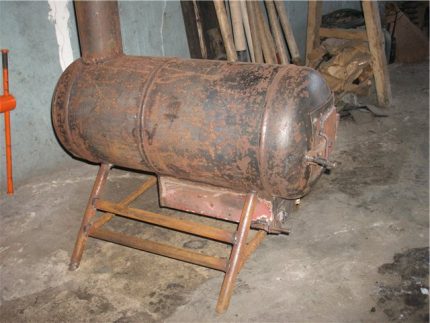
In the lower section, the waste oil burns, which gives a certain amount of heat and turns into a combustible gas. Through the pipe, this gas enters the second combustion chamber, simultaneously mixing with a small amount of air. The resulting gas mixture during combustion produces an impressive amount of heat.
The first chamber in which the used oil is burned can be made of sheet metal or a suitable metal container of a square, round or rectangular configuration.
In order for the combustion process to proceed correctly, a damper is made in this tank to regulate the amount of air entering the chamber.

From below, you need to attach legs from a corner or thick wire, the main thing is that they are strong enough to withstand the metal structure. A round hole is made from above and a perforated pipe is inserted into it.
Typically, this pipe serves as a support for the upper chamber, and is also exposed to high temperatures from burning oil.
Therefore, you need a design with walls thick enough to withstand both extra weight and temperature. Otherwise, it will burn out very soon. The upper chamber is usually made in the form of a short and wide cylinder made of thick metal.
You need to put a chimney on top - the lateral location of the pipe to remove flue gases in this case is not allowed.
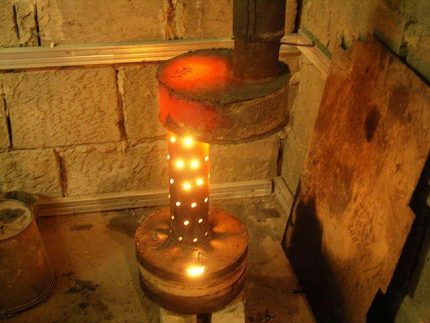
The requirements for the installation of the furnace at work are approximately the same as for the potbelly stove: an even and solid foundation, protection of the surrounding space from overheating and fire. Almost any used oil can be burned in such a furnace: solarium, transmission compounds, fuel oil, diesel fuel, kerosene, etc.
You should refrain from experiments with formulations that are characterized by light and rapid ignition, i.e. from burning gasoline or various solvents in such an oven.
A small amount of gasoline can be used to ignite the mining. And gasoline spilled directly near a preheated oven can cause a serious fire.
It is impossible to officially obtain permission to install such a furnace, it is prohibited by fire safety standards. Owners of a private garage have the right to install such a unit, but they are fully responsible for a possible fire.
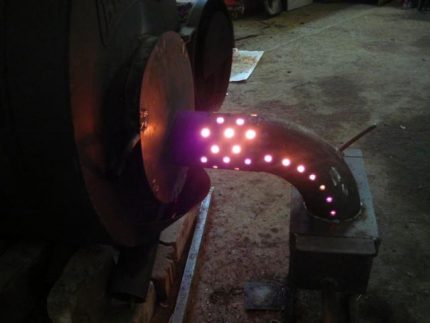
An interesting solution could be hybrid stoves and stoves at workout. To do this, the chamber in which the working out is burned is equipped with a curved perforated tube, and the potbelly stove is made two-chamber so that it can burn not only firewood, but also used oil. The unit can be used for two types of fuel, depending on the situation.
A modified version of the working stove can not only increase the temperature in the garage, but also warm the water for washing hands:
Additional options for home-made garage ovens are described in these articles:
- DIY miracle oven for a garage in a diesel fuel: step-by-step instructions for the construction
- Do-it-yourself garage oven: a step-by-step guide to design
A detailed overview of the manufacture and operation of the furnace for development is presented in the video:
# 4: long burning furnace - high efficiency
The principle of operation of this stove allows you to get the maximum amount of heat when burning ordinary wood. Fuel in large quantities is loaded into the combustion chamber, a moderate amount of oxygen is also fed there. Under such conditions, wood does not burn immediately, but smolders slowly, emitting flammable gas.
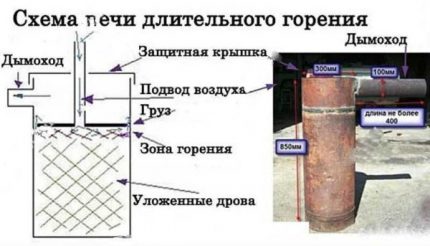
This gas burns in the upper part of the combustion chamber at a very high temperature, which ensures high efficiency of this type of device.
Here you can see the process of creating an interesting option for a long burning furnace:
It is necessary to load fuel in a long-burning furnace no more than twice a day, therefore such devices are more suitable for continuous heating of a garage or for use over a long period of time.
The easiest way to make a long burning furnace from a metal barrel with thick walls. A capacity of about 200 liters is considered optimal for such purposes. From above, you need to make a lid with a chimney and a hole for supplying fresh air necessary for combustion.
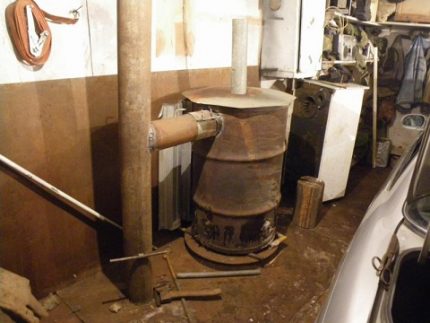
The chimney cross section should be about 150 mm, and the air pipes should be 100 mm. An important element of this type of stove is the load that presses smoldering firewood. To make it, you will need a metal circle a little narrower than the diameter of the barrel, as well as two pieces of a channel that will play the role of a weighting agent.
A hole for supplying air is also made in this element, to which a pipe with a cross section of 100 mm is then welded. It should be slightly longer than the height of the stove body.
On the side they make a loading hole for firewood with a door, and on the bottom they put a grate and a container for ash, weld strong legs.
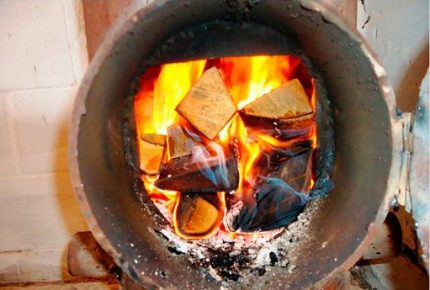
Firewood is burned in a long burning furnace almost completely, leaving a small amount of waste, so a large ash pan is not needed here. To start such a stove, you need to load firewood from above, press them with a load, then cover the structure with a lid by threading an air pipe into the corresponding hole.
As smoldering, the amount of firewood decreases, the load drops. To install such a furnace, a solid foundation and a safe environment are also required.
Can make a buleryan oven - A worthy example of long-burning furnaces.
Heating from the stove is far from the only option for heating the garage. About alternative methods of heat supply for a car box is written in this article.
Conclusions and useful video on the topic
Video presentation of the device in the garage of an autonomous heating system based on a stove:
Options for home-made stoves are quite diverse, and the designs of such devices are not particularly complex. You will need metalwork skills, a welding machine and quite affordable materials. A properly made stove works efficiently and lasts a long time.
Looking for an efficient way to heat your garage? Or have experience in the manufacture and use of the stove? Please leave comments on the article and ask questions on the topic.

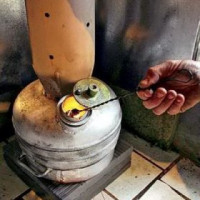 How to make a potbelly stove on waste oil with your own hands: a review of the best homemade products
How to make a potbelly stove on waste oil with your own hands: a review of the best homemade products 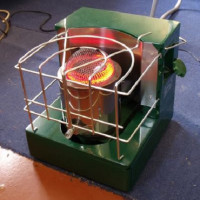 DIY miracle oven for a garage in a diesel fuel: step-by-step instructions for the construction
DIY miracle oven for a garage in a diesel fuel: step-by-step instructions for the construction  Do-it-yourself stove stove: a scheme of a home-made stove for a summer house and garage
Do-it-yourself stove stove: a scheme of a home-made stove for a summer house and garage 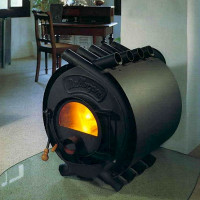 How to make a Buleryan oven with your own hands: step-by-step instructions on how to make
How to make a Buleryan oven with your own hands: step-by-step instructions on how to make 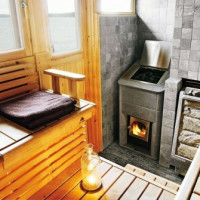 Do-it-yourself gas bath stove: manual for the installation and installation of a gas stove
Do-it-yourself gas bath stove: manual for the installation and installation of a gas stove  Do-it-yourself mini Russian stove: specifics and arrangements for the construction of a compact stove
Do-it-yourself mini Russian stove: specifics and arrangements for the construction of a compact stove  How much does it cost to connect gas to a private house: the price of organizing gas supply
How much does it cost to connect gas to a private house: the price of organizing gas supply  The best washing machines with dryer: model rating and customer tips
The best washing machines with dryer: model rating and customer tips  What is the color temperature of light and the nuances of choosing the temperature of the lamps to suit your needs
What is the color temperature of light and the nuances of choosing the temperature of the lamps to suit your needs  Replacement of a geyser in an apartment: replacement paperwork + basic norms and requirements
Replacement of a geyser in an apartment: replacement paperwork + basic norms and requirements
Personally, I would not risk using the furnace for working out precisely because of its fire hazard. It seems to me that the best option would be to install a cast iron stove. It warms up quite quickly, while also giving off heat for a long time. In principle, it provides smoother and more uniform heating than a simple steel potbelly stove. Although the price of this option is slightly higher.
I plan to get a similar device in my garage. I thought I'd buy it before, but it became interesting to try to make something like this with my own hands. Of course, I have little experience in this. I have a garage of only 18 square meters, tell me the best option for such an area. That the heating was good. What is the best place to build a stove to heat the garage if I am in it for a couple or a little more hours a day?
For heating the garage 18 meters square. You can consider several options for stoves:
1. To make of sheet metal 3 mm and tubes 57kh3.5mm;
2. To make the furnace from a gas cylinder.
The second option is a little simpler, in fact, you have to upgrade the gas cylinder in a long-burning furnace. For the first option, you have to make everything from scratch.
Let me know which of these options you are more interested in, then I will write down what and how in more detail (materials, tools). In any case, you need a welding inverter and a plasma cutter.
If you buy a stove after all, then it is better to choose a buleryan. And if you experiment yourself, then build like a potbelly stove. As for me, there is simply no more reliable option. In addition, time-tested, fellow revolutionaries. It’s easy to do. The main thing is that there is welding. And you can easily start working out. But alas, you can’t do this with a buller.